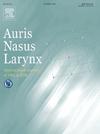Early detection and successful management of postoperative external jugular vein thrombosis using color doppler ultrasonography after free jejunal transfer
IF 1.5
4区 医学
Q2 OTORHINOLARYNGOLOGY
引用次数: 0
Abstract
Postoperative venous thrombosis is a known complication of free flap reconstruction, yet thrombosis of the external jugular vein (EJV) remains underreported. We present two cases of EJV thrombosis following free jejunal transfer, both detected early using color Doppler ultrasonography (CDU) and successfully managed with anticoagulation therapy. In Case 1, EJV was used after failure of a prior jejunal flap anastomosed to the internal jugular vein (IJV). CDU on postoperative day (POD) 0 showed thrombus characterized by flow voids and incomplete vein collapse, prompting heparin administration. In Case 2, CDU on POD 1 similarly revealed early thrombus in the EJV. In both cases, daily CDU monitoring demonstrated progressive improvement, allowing flap salvage without surgical reintervention. These cases highlight the utility of CDU for early postoperative surveillance and timely clinical decision-making. CDU facilitated early detection of venous thrombosis, often preceding clinical signs of vascular compromise. Although less favored than the IJV, the EJV can be safely used for microvascular anastomosis with careful monitoring. Our experience supports the use of CDU to guide anticoagulation therapy and optimize outcomes in free flap reconstruction involving the EJV.
游离空肠移植术后颈外静脉血栓形成的彩色多普勒超声早期发现及成功处理。
术后静脉血栓形成是游离皮瓣重建的一个已知并发症,但颈外静脉血栓形成(EJV)仍未被报道。我们报告了两例游离空肠移植后EJV血栓形成的病例,均通过彩色多普勒超声(CDU)早期发现并成功地进行了抗凝治疗。在病例1中,在先前的空肠皮瓣与颈内静脉(IJV)吻合失败后使用EJV。CDU术后第0天(POD)显示血栓,以血流空洞和静脉不完全塌陷为特征,提示给予肝素治疗。在病例2中,POD 1上的CDU同样显示EJV有早期血栓。两例患者每日CDU监测均显示进展性改善,无需手术再干预即可保留皮瓣。这些病例突出了CDU在术后早期监测和及时临床决策中的作用。CDU有助于早期发现静脉血栓形成,通常在血管损伤的临床症状之前。虽然不像IJV那样受欢迎,但在仔细的监测下,EJV可以安全地用于微血管吻合。我们的经验支持使用CDU来指导抗凝治疗和优化包括EJV的自由皮瓣重建的结果。
本文章由计算机程序翻译,如有差异,请以英文原文为准。
求助全文
约1分钟内获得全文
求助全文
来源期刊

Auris Nasus Larynx
医学-耳鼻喉科学
CiteScore
3.40
自引率
5.90%
发文量
169
审稿时长
30 days
期刊介绍:
The international journal Auris Nasus Larynx provides the opportunity for rapid, carefully reviewed publications concerning the fundamental and clinical aspects of otorhinolaryngology and related fields. This includes otology, neurotology, bronchoesophagology, laryngology, rhinology, allergology, head and neck medicine and oncologic surgery, maxillofacial and plastic surgery, audiology, speech science.
Original papers, short communications and original case reports can be submitted. Reviews on recent developments are invited regularly and Letters to the Editor commenting on papers or any aspect of Auris Nasus Larynx are welcomed.
Founded in 1973 and previously published by the Society for Promotion of International Otorhinolaryngology, the journal is now the official English-language journal of the Oto-Rhino-Laryngological Society of Japan, Inc. The aim of its new international Editorial Board is to make Auris Nasus Larynx an international forum for high quality research and clinical sciences.
 求助内容:
求助内容: 应助结果提醒方式:
应助结果提醒方式:


